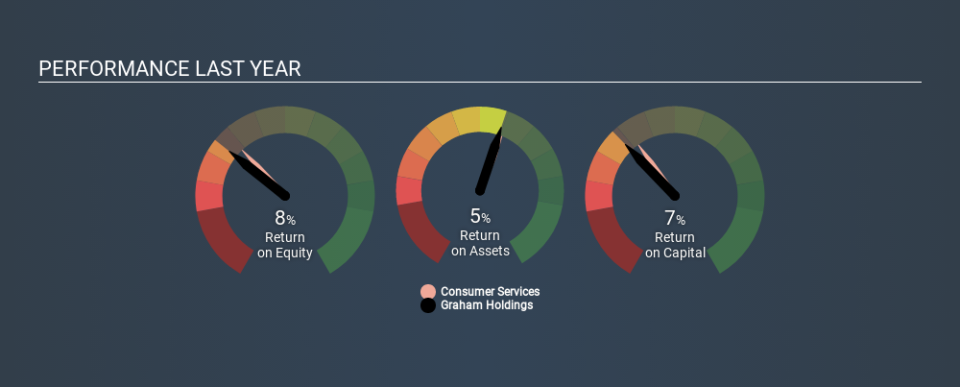Here’s why Graham Holdings Company’s (NYSE:GHC) Returns On Capital Matters So Much

Today we are going to look at Graham Holdings Company (NYSE:GHC) to see whether it might be an attractive investment prospect. Specifically, we're going to calculate its Return On Capital Employed (ROCE), in the hopes of getting some insight into the business.
First of all, we'll work out how to calculate ROCE. Second, we'll look at its ROCE compared to similar companies. And finally, we'll look at how its current liabilities are impacting its ROCE.
What is Return On Capital Employed (ROCE)?
ROCE measures the 'return' (pre-tax profit) a company generates from capital employed in its business. Generally speaking a higher ROCE is better. In brief, it is a useful tool, but it is not without drawbacks. Renowned investment researcher Michael Mauboussin has suggested that a high ROCE can indicate that 'one dollar invested in the company generates value of more than one dollar'.
How Do You Calculate Return On Capital Employed?
The formula for calculating the return on capital employed is:
Return on Capital Employed = Earnings Before Interest and Tax (EBIT) ÷ (Total Assets - Current Liabilities)
Or for Graham Holdings:
0.067 = US$303m ÷ (US$5.5b - US$989m) (Based on the trailing twelve months to September 2019.)
So, Graham Holdings has an ROCE of 6.7%.
Check out our latest analysis for Graham Holdings
Does Graham Holdings Have A Good ROCE?
When making comparisons between similar businesses, investors may find ROCE useful. Using our data, Graham Holdings's ROCE appears to be significantly below the 8.8% average in the Consumer Services industry. This performance is not ideal, as it suggests the company may not be deploying its capital as effectively as some competitors. Setting aside the industry comparison for now, Graham Holdings's ROCE is mediocre in absolute terms, considering the risk of investing in stocks versus the safety of a bank account. It is possible that there are more rewarding investments out there.
You can click on the image below to see (in greater detail) how Graham Holdings's past growth compares to other companies.
When considering ROCE, bear in mind that it reflects the past and does not necessarily predict the future. ROCE can be misleading for companies in cyclical industries, with returns looking impressive during the boom times, but very weak during the busts. ROCE is only a point-in-time measure. How cyclical is Graham Holdings? You can see for yourself by looking at this free graph of past earnings, revenue and cash flow.
Graham Holdings's Current Liabilities And Their Impact On Its ROCE
Current liabilities include invoices, such as supplier payments, short-term debt, or a tax bill, that need to be paid within 12 months. Due to the way the ROCE equation works, having large bills due in the near term can make it look as though a company has less capital employed, and thus a higher ROCE than usual. To check the impact of this, we calculate if a company has high current liabilities relative to its total assets.
Graham Holdings has current liabilities of US$989m and total assets of US$5.5b. Therefore its current liabilities are equivalent to approximately 18% of its total assets. This is a modest level of current liabilities, which would only have a small effect on ROCE.
The Bottom Line On Graham Holdings's ROCE
That said, Graham Holdings's ROCE is mediocre, there may be more attractive investments around. You might be able to find a better investment than Graham Holdings. If you want a selection of possible winners, check out this free list of interesting companies that trade on a P/E below 20 (but have proven they can grow earnings).
For those who like to find winning investments this free list of growing companies with recent insider purchasing, could be just the ticket.
If you spot an error that warrants correction, please contact the editor at editorial-team@simplywallst.com. This article by Simply Wall St is general in nature. It does not constitute a recommendation to buy or sell any stock, and does not take account of your objectives, or your financial situation. Simply Wall St has no position in the stocks mentioned.
We aim to bring you long-term focused research analysis driven by fundamental data. Note that our analysis may not factor in the latest price-sensitive company announcements or qualitative material. Thank you for reading.

 Yahoo Finance
Yahoo Finance 
